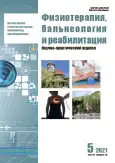Применение микронидлинга и лазеротерапии у пациентов с инволютивными изменениями кожи
- Авторы: Круглова Л.С.1, Авагумян М.А.1, Тамразова А.В.1
-
Учреждения:
- Центральная государственная медицинская академия Управления делами Президента РФ
- Выпуск: Том 20, № 5 (2021)
- Страницы: 397-404
- Раздел: Оригинальные исследования
- URL: https://journals.rcsi.science/1681-3456/article/view/107862
- DOI: https://doi.org/10.17816/rjpbr107862
- ID: 107862
Цитировать
Аннотация
Обоснование. Инволютивные изменения кожи представляют собой актуальную проблему в современном мире, что подводит к необходимости поиска комплексного и эффективного метода лечения, направленного на снижение активности матриксных металлопротеиназ (ММР) и трансформирующего фактора роста β2 (TGF-β2), ответственных за деградацию белков внеклеточного матрикса.
Цель исследования ― определить степень влияния монотерапии микронидлинга, фракционного лазера, а также комбинацию этих методов на содержание ММР-2, ММР-3, ММР-12, TGF-β2 в коже пациентов с инволютивными признаками.
Материал и методы. В одноцентровом проспективном параллельном нерандомизированном исследовании приняли участие 82 пациента с инволютивными изменениями кожи лица, которые были разделены на 3 группы: 26 пациентов (группа 1) получали монотерапию микронидлинга (3 процедуры кратностью 1 раз в 3 нед), 27 пациентов (группа 2) ― монотерапию фракционным лазером (3 процедуры кратностью 1 раз в 4 нед), 29 пациентов (группа 3) ― комбинированную терапию микронидлинга и фракционным лазером (по 3 процедуры кратностью 1 раз в 4 нед). Исследование длилось 10 нед, до и после начала исследования была взята биопсия кожи заушной области для определения уровней ММР-2, -3, -12 и TGF-β2.
Результаты. Сравнительные данные иммуноферментного анализа с конъюгатами биотинмоноклональных антител ММР-2, -3, -12, TGF-β2 между группами выявили различие в содержании ММР и TGF-β: в 1-й группе отмечалась менее значимая динамика по всем изучаемым показателям по сравнению с 3-й группой: ММР-2 (р=0,0390), ММР-3 (р=0,0466), ММР-12 (р=0,0104) и TGF-β (р=0,0080) и 2-й группой: ММР-12 (р=0,0484) и TGF-β (р=0,0367). При сравнении 2-й и 3-й групп более значимая динамика отмечалась в 3-й группе по показателям ММР-2 (р=0,0290), ММР-12 (р=0,0511) и TGF-β (р=0,0241). Таким образом, наиболее значимые результаты были получены в группе комбинированной терапии (группа 3).
Заключение. Комбинированное лечение с использованием микронидлинга и фракционного лазера приводит к значимому снижению уровней ММР-2, -3, -12 и TGF-β2, что позволяет рассматривать данный терапевтический комплекс как перспективный способ коррекции инволютивных изменений кожи.
Ключевые слова
Полный текст
Открыть статью на сайте журналаОб авторах
Лариса Сергеевна Круглова
Центральная государственная медицинская академия Управления делами Президента РФ
Email: kruglovals@mail.ru
ORCID iD: 0000-0002-5044-5265
SPIN-код: 1107-4372
д.м.н., профессор
Россия, МоскваМария Армаисовна Авагумян
Центральная государственная медицинская академия Управления делами Президента РФ
Email: maruya-kamalova@yandex.ru
ORCID iD: 0000-0003-1898-678X
Россия, Москва
Анаит Вардановна Тамразова
Центральная государственная медицинская академия Управления делами Президента РФ
Автор, ответственный за переписку.
Email: anaittamrazova@gmail.com
ORCID iD: 0000-0002-4672-697X
Россия, Москва
Список литературы
- Puizina-Ivić N. Skin aging // Acta Dermatovenerol Alp Pannonica Adriat. 2008. Vol. 17, N 2. Р. 47–54.
- Chen B., Li R., Yan N., et al. Astragaloside IV controls collagen reduction in photoaging skin by improving transforming growth factor-β/Smad signaling suppression and inhibiting matrix metalloproteinase-1 // Mol Med Rep. 2015. Vol. 11, N 5. Р. 3344–3348. doi: 10.3892/mmr.2015.3212
- Jiang X., Ge H., Zhou C., et al. The role of transforming growth factor β1 in fractional laser resurfacing with a carbon dioxide laser // Lasers Med Sci. 2014. Vol. 29, N 2. Р. 681–687. doi: 10.1007/s10103-013-1383-5
- Тарасова О.В., Кручинская М.Г., Авагумян М.А. Анализ распределения полиморфизмов генов MMP1, XRCC1, HFE (2), GSTT у пациентов с инволютивными изменениями кожи в зависимости от морфотипа // Кремлевская медицина. Клинический вестник. 2018. № 4. С. 168–174.
- Doucas V., Shi Y., Miyamoto S., et al. Cytoplasmic catalytic subunit of protein kinase A mediates cross-repression by NF-kappa B and the glucocorticoid receptor // Proc Natl Acad Sci USA. 2000. Vol. 97, N 22. Р. 11893–11898. doi: 10.1073/pnas.220413297
- Alexiades-Armenakas M.R., Dover J.S., Arndt K.A. Fractional laser skin resurfacing // J Drugs Dermatol. 2012. Vol. 11, N 11. Р. 1274–1287.
- Fernandes D., Signorini M. Combating photoaging with percutaneous collagen induction // Clin Dermatol. 2008. Vol. 26, N 2. Р. 192–199. doi: 10.1016/j.clindermatol.2007.09.006
- Patil U.A., Dhami L.D. Overview of lasers // Indian J Plast Surg. 2008. Vol. 41, Suppl. Р. 101–113.
- Fernandes D. Minimally invasive percutaneous collagen induction. Oral Maxillofac Surg Clin North Am // 2005. Vol. 17, N 1. Р. 51–63. doi: 10.1016/j.coms.2004.09.004
- Orentreich D.S., Orentreich N. Subcutaneous incisionless (subcision) surgery for the correction of depressed scars and wrinkles // Dermatol Surg. 1995. Vol. 21, N 6. Р. 543–549. doi: 10.1111/j.1524-4725.1995.tb00259.x
Дополнительные файлы







